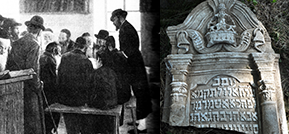Kolomyia
| Years | State | Province | District |
| Till 1772 | Polish-Lithuanian Commonwealth: Kingdom of Poland |
Rus Voivodship (Województwo ruskie) |
|
| 1772-1914 | "Hapsburg Empire", since 1804 - Austrian Empire, since 1867 - Austro-Hungarian Monarchy | Kingdom of Galicia and Lodomeria (Königreich Galizien und Lodomerien) | Kołomyia powiat |
| 1914-1915 | Under Russian occupation | General-Government Galitsiia | Kołomyia uezd |
| 1915-1918 | Austro-Hungarian Monarchy |
Kingdom of Galicia and Lodomeria (Königreich Galizien und Lodomerien) |
Kołomyia powiat |
| 1918 - May 1919 | West-Ukrainian People's Republic | ||
| May 1919 - September 1939 | Republic of Poland | Stanislawów wojewódstwo | Kołomyia powiat |
| September 1939 - June 1941 | USSR: Ukrainian Soviet Socialist Republic | Stanislav oblast' | Kolomyia raion |
| June 1941 - July 1944 | Under German occupation:
General Government (Das Generalgouvernement für die besetzten polnischen Gebiete) |
Distrikt Galizien | |
| 1944-91 | USSR: Ukrainian Soviet Socialist Republic | Stanislavov (Stanislaviv) oblast'; since 1962 renamed Ivano-Frankovsk (Ivano-Frankivs'k) oblast' | Kolomyia raion |
| Since 1991 | Republic of Ukraine | Ivano-Frankivs'k oblast' | Kolomyia raion |
Kolomea is a city located on the Prut river, 65 km from Ivano-Frankivsk. The city rests approximately halfway between Lviv and Chernivtsi (Czernowitz), in the center of the historical region of Pokuttya.
Kolomia, the most developed city in Pokuttya at the time, boasted a large Jewish community – on the eve of the Second World War its numbers reached 18,930 (out of a general population of 42,676). This community was culturally vibrant and complex, and its influence on the Jewish culture of Galicia was significant. Before the Holocaust there were approximately 50 operational synagogues in Kolomia, among them the magnificent “Die Hoiche Shul,” a Yerushalmi synagogue, diverse Hassidic kloizes and a Zionist synagogue. One of the central rabbinic figures of Europe, Rabbi Hillel Lichtenstein, presided as the Rabbi of the city for 23 years (1815-1895). Rabbi Lichtenstein was particularly active in the battle waged between the progressive and orthodox factions over the shaping of modern Judaism during the second half of the 19th century. Jewish political and cultural organizations which developed toward the end of the 19th century enriched communal life, and the city was home to a variety of educational institutions, reflecting a wide array of ideological stances. Between the two World Wars a public library, named after Yitzhok Leibush Peretz, operated in the city.
Kolomia’s Jews had an important role in the economic development of the region. There were many Jewish businesses in the city: flour mills, beer breweries, banks, tanneries, weaving and prayer shawls factories and brick-making factories, oil refineries and more.
Jewish printers published books and other materials, not only for Jews but also for their Christian neighbors – Polish or Ukranian.
Beginning in the second half of the 19th centuries, Jews took an active part in the communal and political life of the city. Kolomian Jews were chosen as representatives for the Galician Sejm and the Vienna Parliament. Jews had respectable representation in municipal government and Jewish representatives were even appointed to mayoral and vice-mayoral positions.
During the Holocaust all of the Jews of Kolomia and its environs were concentrated in a ghetto comprised of three separate sections. During 1942 these sections were burned and the entire population of the ghetto was destroyed: some were murdered in the city streets, others were taken to the Belzec extermination camp, and the rest were shot in the forest adjoining the village of Sheparivtsy, near the city. Nowadays there are several dozen Jews living in Kolomia – the descendants of the families who settled in the city after its liberation by the Soviet army.
| Year | Total | Jews | Percentage of Jews |
| 1765 | - | 1,057 | - |
| 1880 | 23,109 | 12,002 | 51.9% |
| 1890 | 30,235 | 14,927 | 49.3% |
| 1900 | 34,188 | 16,568 | 48.4% |
| 1910 | 42,676 | 18,930 | 44.3% |
| 1920 | 31,708 | 14,544 | 45.8% |
| 1931 | 14,332 | ||
| 1993 | 68,000 | ||
| 2005 | 61,210 |
פריטים רלוונטיים לקהילה
| כותרת |
סוג הפריט |
שנה |
|---|---|---|
| Hospital and community nursing home | מבנים | |
| Office building | מבנים | |
| Jewish Gymnasium for girls | מבנים | |
| Market square | מבנים | |
| Polish sport club "Sokół" | מבנים | 1895 |
| Jewish Gymnasium for boys | מבנים | |
| Old buildings on Teatral'na | מבנים | |
| Bureau for Emigration to American countries | מבנים | |
| House on the market square | מבנים | |
| Baruch Feierstein appartment | מבנים |






